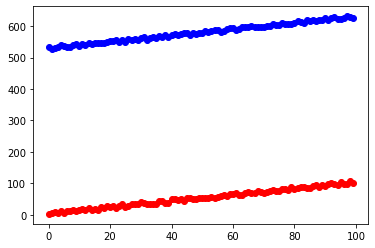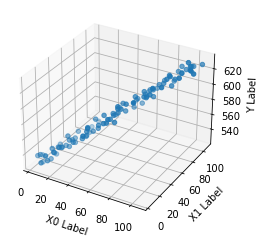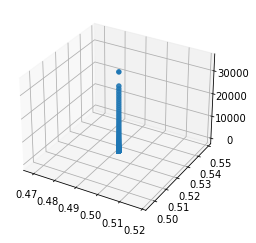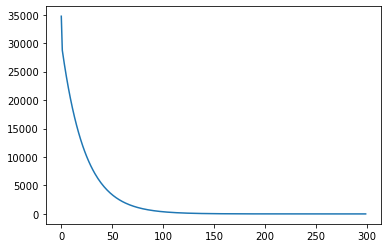
Multivariate Linear Regression
한 개 이상의 feature로 구성된 데이터를 분석할 경우에 대한 예시
식은 많아지지만 여전히 Cost 함수의 최적화!
from sklearn.datasets import load_boston
import matplotlib.pyplot as plt
import numpy as np
import random
%matplotlib inlinedef gen_data(numPoints, bias, variance):
x = np.zeros(shape=(numPoints, 3))
y = np.zeros(shape=numPoints)
# basically a straight line
for i in range(0, numPoints):
# bias feature
x[i][0] = random.uniform(0, 1) * variance + i
x[i][1] = random.uniform(0, 1) * variance + i
x[i][2] = 1
# our target variable
y[i] = (i+bias) + random.uniform(0, 1) * variance + 500
return x, y
# gen 100 points with a bias of 25 and 10 variance as a bit of noise
x, y = gen_data(100, 25, 10)
plt.plot(x[:, 0:1], "ro")
plt.plot(y, "bo")
plt.show()
from mpl_toolkits.mplot3d import Axes3D
fig = plt.figure()
ax = fig.add_subplot(111, projection='3d')
ax.scatter(x[:,0], x[:,1], y)
ax.set_xlabel('X0 Label')
ax.set_ylabel('X1 Label')
ax.set_zlabel('Y Label')
plt.show()
def compute_cost(x, y, theta):
'''
Comput cost for linear regression
'''
#Number of training samples
m = y.size
predictions = x.dot(theta)
sqErrors = (predictions - y)
J = (1.0 / (2 * m)) * sqErrors.T.dot(sqErrors)
return Jdef minimize_gradient(x, y, theta, iterations=100000, alpha=0.01):
m = y.size
cost_history = []
theta_history = []
for _ in range(iterations):
predictions = x.dot(theta)
for i in range(theta.size):
partial_marginal = x[:, i]
errors_xi = (predictions - y) * partial_marginal
theta[i] = theta[i] - alpha * (1.0 / m) * errors_xi.sum()
if _ % 1000 == 0:
theta_history.append(theta)
cost_history.append(compute_cost(x, y, theta))
return theta, np.array(cost_history), np.array(theta_history)theta_initial = np.ones(3)
theta, cost_history, theta_history = minimize_gradient(
x, y,theta_initial, 300000, 0.0001)
print("theta", theta)theta [4.93298835e-01 5.22320509e-01 5.24189528e+02]
from sklearn import linear_model
regr = linear_model.LinearRegression()
regr.fit(x[:,:2], y)
# # The coefficients
print('Coefficients: ', regr.coef_)
print('intercept: ', regr.intercept_) Coefficients: [0.48987299 0.5151403 ]
intercept: 524.9299681230468
print(np.dot(theta, x[10]))
print(regr.predict(x[10,:2].reshape(1,2))) 541.0742166870866
[541.63503242]
from mpl_toolkits.mplot3d import Axes3D
from matplotlib import cm
import matplotlib.pyplot as plt
import numpy as np
fig = plt.figure()
ax = fig.add_subplot(111, projection='3d')
ax.scatter3D(theta_history[:,0],theta_history[:,1], cost_history, zdir="z")
plt.show()
plt.plot(cost_history)
plt.show() 
